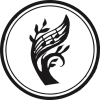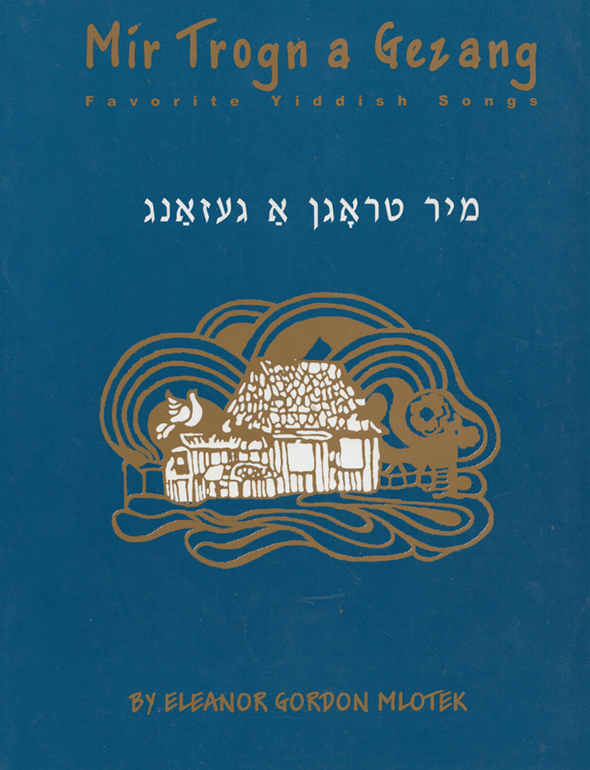Text by Shmerke Kaczerginski (1908-1954), Vilna poet, folklorist and partisan fighter. Kaczerginski was among the first to collect and publish the songs of the ghettos and concentration camps. The song, written right after the holocaust, expresses the eternal hope and longing for salvation. The song was published in the Kaczerginski Memorial Volume in Argentina in 1955. Kaczerginski was killed in a plane crash in 1954. In a manuscript sent to the compiler of this book, before his death, he noted that the music of the song is by Rabbi Abraham Isaac Kook. Sidor Belarsky also wrote music to the poem.
The premise of this upbeat song is, the Messiah will come when there is either a completely righteous or a completely wicked generation. So, in our times [says the poet ironically, with a glass of booze in hand], sinning will actually bring Moshiekh sooner!

When we’re feeling low, we raise a glass.
If the melancholy won’t leave us be, we sing a song.
If there is not a bit of liquor, then let us drink water.
Fresh water is aqua-vitae*, what more does a Jew need?
Let the Redemption come, already,
The Messiah is coming soon.
It’s a completely wicked generation, don’t be fools,
and through sinning – the Messiah will come faster.
Oh, You, dear Father in heaven, we children of mercy pray,
see to it that the Messiah does not come just a little too late.
Trees are dancing in the woods, stars in the sky,
Reb Israel, father of the bride, is dancing in their midst.
It will wake up the Messiah from his groggy nap,
when he hears our prayerful song.
*a word play. “Mayim-khayim”, fresh flowing water, also means, “the water of life,” known in Europe via the Latin, and a slang term for liquor.
Ongezolyet oyfn hartsn, makht men a lekhayim,
Oyb der umet lozt nit ruen — zingen mir a lid.
lz nito keyn bisl bronfn — lomir trinken mayim,
Mayim-khayim iz dokh khayim — vos darf nokh der yid?
CHORUS:
Zol shoyn kumen di geule
Meshiekh kumt shoyn bald!
S’iz a dor fun kule-khayev, zayt nit keyn naronim —
Un fun zindikn — Meshiekh gikher kumen vet!
Akh, du tatele, in himl, s’betn bney rakhmonim;
Ze, Meshiekh zol nit kumen a bisele tsu shpet. . .
S’tantsn beymer in di velder, shtern oyfn himl,
Reb Yisroel, der mekhutn, dreyt zikh in der mit,
S’vet zikh oyfvekn Meshiekh fun zayn tifn driml
Ven er vet derhern undzer tfiledike lid.
אָנגעזאָליעט אױפֿן האַרצן, מאַכט מען אַ לחײם,
אױב דער אומעט לאָזט ניט רוען — זינגען מיר אַ ליד.
איז ניטאָ קײן ביסל בראָנפֿן — לאָמיר טרינקען מים,
מים-חײם איז דאָך חײם — װאָס דאַרף נאַך א ייִד?
רעפֿרײן:
זאָל שױן קומען די גאולה,
משיח קומט שױן בֿאַלד!
ס’איז אַ דור פֿון כּולו חייבֿ, זײַט ניט קײן נאַראָנים —
און פֿון זינדיקן — משיח גיכער קומען װעט!
אַך, דו טאַטעלע אין הימל, ס’בעטן בני רחמנים:
זע, משיח זאָל ניט קומען א ביסעלע צו שפּעט . . .
ם’טאַנצן בײמער אין די װעלדער, שטערן אױפֿן הימל,
ר׳ ישׂראל, דער מחותן דרײט זיך אין דער מיט,
ס’װעט זיך אױפֿװעקן משיח פֿון זײַן טיפֿן דרימל
װען ער װעט דערהערן אונדזער תּפֿילהדיקע ליד.
Song Title: Zol Shoyn Kumen Di Geule!

First published in 1972, Mir Trogn A Gezang: Favorite Yiddish Songs was reprinted six more times (in 1977, 1982, 1985, 1987, 1988, 2000) due to popular demand. The songs in this anthology represent a sampling of beloved folk and well-known Yiddish songs, many of which are scattered in various song collections; some appear in very rare and inaccessible collections; and some were never before published. Folk songs comprise about a third of this volume and were selected mainly on the basis of popularity and sometimes for their historic significance. Needless to say, they are only representative of the vast, rich treasure of Yiddish folk material. The selection was made not only on the basis of personal preference, but in the knowledge they are favorites of many who sing these songs. Most of the songs represent the repertoire that was sung at Yiddish summer camps, May 1st demonstrations and at social gatherings. Many songs were introduced to American Jewry by Jewish immigrants who came to the United States after World War II, for whom these songs had been favorites in Poland and other East European communities destroyed by the Nazis.